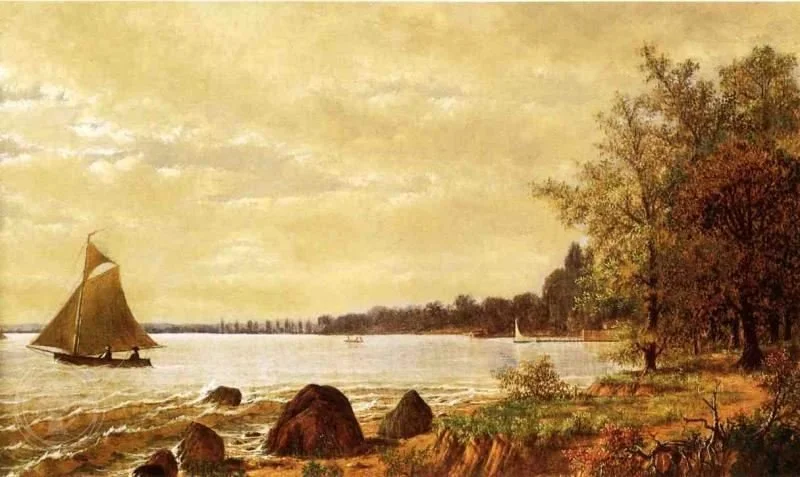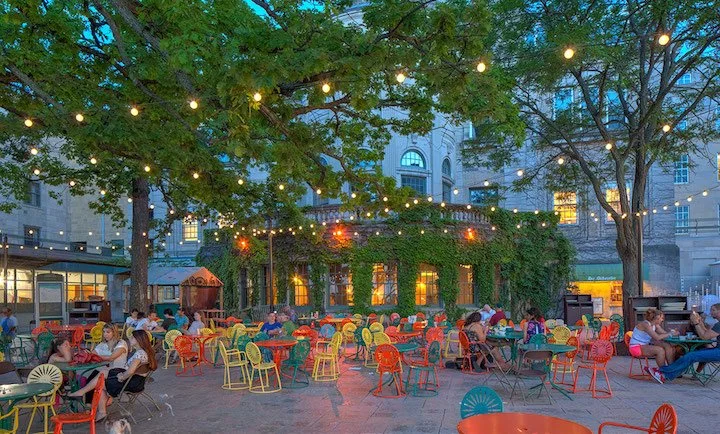Serenade for Ten Instruments (1999)
For Flute, Oboe, Clarinet, Bassoon, Horn, Trumpet, Violin, Viola, Violoncello, and Contrabass
Duration: 25’
Movements: Waves (3:34) | Variations: Donde esta mi querida? (8:12) | Intermezzo (6:01) | Mixed Doubles (4:25)
First Performance: 3 October 1999 / First Unitarian Society, Madison, Wisconsin / Oakwood Chamber Players / James Smith
Dedication: “Commissioned by the Oakwood Chamber Players, Madison, Wisconsin, and dedicated to David Del Tredici.”
Publisher: Peermusic Classical
Lake Mendota, painting: Joseph Rusling Meeger, 1870. Public Domain
The UW-Madison Union Terrace on a midsummer evening. p/c: UW-Madison.
Program Note:
As the title suggests, Serenade for Ten Instruments explores the original format and instrumentation of the great romantic serenades of Brahms and Mozart, bringing them into the modern era by infusing them with the easygoing, yet sophisticated Midwestern spirit of Madison, Wisconsin on a typical summer evening. Geographically situated on an isthmus between two lakes—Monona and Mendota—Madison is at once the seat of State government and home to the State’s land grant University.
The first movement, Waves, is a musical portrait of Lake Mendota in the late afternoon inspired by Joseph Rusling Meeger's 1870 painting Lake Mendota. This musical memory-portrait is shaped structurally like an arch. The pitches are organized into three groups. The middle section features a melody in the horn ornamented with elaborate runs in the winds. The closing section combines the ornamental runs of the second section with a recapitulation of the opening canons.
Historically, serenades featured a solo singer accompanied by a small ensemble. Variations: Donde esta mi querida? (the second movement) is a set of eight variations on an original melody (Where is my beloved?) from Hagen’s opera Bandanna. In the opera, a man (Jake) standing out in the street in front of his home at dusk, watching his wife through the window as she brushes her hair in the warm light of a single lamp sings this melody. He's remembering it as though it were an old, familiar tune.
Intermezzo, the movement that follows, is set, according to Hagen, “just after dusk on the Memorial Union patio, with the lake before us and the Union behind. It is a conversation in three parts between old friends (first in the strings, then in the winds)—each of whom mulls over the same melody before handing it off fugally to the next. I leaned into a Mozartian Serenata notturna feel crossed with a pensive Bernsteinian concert music language reminiscent of Hindemith.”
The final movement, Mixed Doubles, is a fun, fast rondo in which every instrument has a musical doppelgänger, which shadows it either rhythmically or melodically. The half steps that organized the first movement return, while the first idea of the rondo is based on the Intermezzo theme.
Commissioned by the Oakwood Chamber Players, Hagen composed it in July 1999 at Yaddo; it was first performed on October 3rd, 1999 at the First Unitarian Society in Madison, Wisconsin. The group recorded the work under the baton of James Smith for the disc Songs of Madness and Sorrow on the Arsis label in 2000.
-- Daron Hagen, 1999


